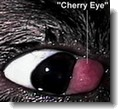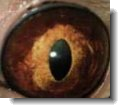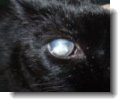

Cat Eye Health: Disorders, Symptoms, Treatments
Understanding The Signs Of Eye Disorders:
Eye disorders in cats are among the easiest to recognize: many involve inflammation to the conjunctiva, the membrane that covers the cornea. Check with your vet if you see any of the following - they may indicate a primary eye disorder; a secondary one, such as FIV, FeLV, or FIP infection; or even cancer:
-Squinting
-Discharge
-Cloudiness
-Redness or inflammation
-Visible third eyelid
-Tear overflow
-Bulging or sunken eye
-Crust or inflammation around the eye
-Deterioration or loss of vision
-Increased irritability associated with pain
Eye disorders in cats are among the easiest to recognize: many involve inflammation to the conjunctiva, the membrane that covers the cornea. Check with your vet if you see any of the following - they may indicate a primary eye disorder; a secondary one, such as FIV, FeLV, or FIP infection; or even cancer:
-Squinting
-Discharge
-Cloudiness
-Redness or inflammation
-Visible third eyelid
-Tear overflow
-Bulging or sunken eye
-Crust or inflammation around the eye
-Deterioration or loss of vision
-Increased irritability associated with pain
Types Of Eye Discharge And Probable Causes:
Watery: A clear, colorless discharge usually indicates physical or allergic irritation.
Jelly-like Mucus: Irritation or infection triggers increased protective mucus production.
Yellow-Green: This is pus. Bacterial infection is present and must be treated.
Staining To The Hair Below The Eyes: Tears overflow when tear drainage is blocked. This is called epiphora and is most common in flat-faced Persians.
Watery: A clear, colorless discharge usually indicates physical or allergic irritation.
Jelly-like Mucus: Irritation or infection triggers increased protective mucus production.
Yellow-Green: This is pus. Bacterial infection is present and must be treated.
Staining To The Hair Below The Eyes: Tears overflow when tear drainage is blocked. This is called epiphora and is most common in flat-faced Persians.
Corneal Injuries:
Damage to the cornea, known as ulcerative keratitis, can be caused by infection or during fights. Local swelling occurs, causing a cloudy appearance. Abrasions can develop into ulcers. Viral corneal damage is often accompanied by sticky conjunctivitis that can glue the eyelids together. Treatment: Your vet will clean the eyes and use appropriate antibiotics. Urgent surgery may be needed to save the eye.
Damage to the cornea, known as ulcerative keratitis, can be caused by infection or during fights. Local swelling occurs, causing a cloudy appearance. Abrasions can develop into ulcers. Viral corneal damage is often accompanied by sticky conjunctivitis that can glue the eyelids together. Treatment: Your vet will clean the eyes and use appropriate antibiotics. Urgent surgery may be needed to save the eye.
Cherry Eye:
Prolapsed gland of the third eyelid, or cherry eye, is a somewhat rare condition that occurs in cats when the gland located at the base of the third eyelid breaks lose from its attachment to the lid and visibly pokes outward. It is mostly hereditary, particularily so with the Burmese and Persian breeds. Treatment: Options include your vet removing part of the gland or forcing the gland to stay put by tacking down the migrating portion to the inner part of the third eyelid. You can keep the eye clean by removing any discharge accumulating in the inner corner of the eye. Flushing the eye with a mild boric acid solution is also advised.
Prolapsed gland of the third eyelid, or cherry eye, is a somewhat rare condition that occurs in cats when the gland located at the base of the third eyelid breaks lose from its attachment to the lid and visibly pokes outward. It is mostly hereditary, particularily so with the Burmese and Persian breeds. Treatment: Options include your vet removing part of the gland or forcing the gland to stay put by tacking down the migrating portion to the inner part of the third eyelid. You can keep the eye clean by removing any discharge accumulating in the inner corner of the eye. Flushing the eye with a mild boric acid solution is also advised.
Cataracts In Cats:
A cataract in your cat is a loss of transparency in part or all of the lens. A complete cataract creates a crystalline white lens with a slightly yellow tint. Physical injury is the most common cause of a single cataract, while sugar diabetes is the most common cause of bilateral cataracts. Treatment: Cataracts can be removed if and when they cause complete blindness.
A cataract in your cat is a loss of transparency in part or all of the lens. A complete cataract creates a crystalline white lens with a slightly yellow tint. Physical injury is the most common cause of a single cataract, while sugar diabetes is the most common cause of bilateral cataracts. Treatment: Cataracts can be removed if and when they cause complete blindness.
Dislodged Lenses:
Known causes of either partial (subluxation) or complete (luxation) lens position changes include trauma from cat fights to road traffic accidents, inflammation of the anterior chamber of the eye, glaucoma, or simply aging. Treatment: Surgery is usually needed.
Known causes of either partial (subluxation) or complete (luxation) lens position changes include trauma from cat fights to road traffic accidents, inflammation of the anterior chamber of the eye, glaucoma, or simply aging. Treatment: Surgery is usually needed.
Glaucoma:
In a healthy cat, there is a constant, slow exchange of liquid from inside the eye into the general circulation. Glaucoma occurs when this fluid is produced faster than it is removed, causing a buildup of pressure in the eye. Symptoms of glaucoma in your cat include squinting, excess tearing, avoidance of light, and swelling to the eye. Treatment: Surgical removal of the eye may be necessary.
In a healthy cat, there is a constant, slow exchange of liquid from inside the eye into the general circulation. Glaucoma occurs when this fluid is produced faster than it is removed, causing a buildup of pressure in the eye. Symptoms of glaucoma in your cat include squinting, excess tearing, avoidance of light, and swelling to the eye. Treatment: Surgical removal of the eye may be necessary.
Retinal Disorders:
Progressive retinal atrophy, an inherited deterioration to the retina, is rare in cats, but through trauma or disease the retina may become detached. Treatment: Your cat's retina can be "spot welded" back in place by laser surgery.
Progressive retinal atrophy, an inherited deterioration to the retina, is rare in cats, but through trauma or disease the retina may become detached. Treatment: Your cat's retina can be "spot welded" back in place by laser surgery.




Blindness:
Blindness in your cat can be caused by diabetes; high blood pressure associated with kidney, heart, or other systemic illness; or by eye injuries. How a cat handles blindness depends on its personality and on its owners. Only you, your cat, and your vet can decide how to manage your blind cat.
Blindness in your cat can be caused by diabetes; high blood pressure associated with kidney, heart, or other systemic illness; or by eye injuries. How a cat handles blindness depends on its personality and on its owners. Only you, your cat, and your vet can decide how to manage your blind cat.
Entropion:
Entropion (Eyelid Rolled Inward) occurs sporadically as a hereditary defect in the Persian but can occur in any cat because of scarring of the lower lid following a bout of purulent conjuntivitis or a lacerated eyelid. The rolled in lid produces eye irritation with tearing and severe squinting. Treatment: Entropion in the adult cat can be corrected by surgery.
Entropion (Eyelid Rolled Inward) occurs sporadically as a hereditary defect in the Persian but can occur in any cat because of scarring of the lower lid following a bout of purulent conjuntivitis or a lacerated eyelid. The rolled in lid produces eye irritation with tearing and severe squinting. Treatment: Entropion in the adult cat can be corrected by surgery.

Stenosis (Blockage) Of Nasolacrimal Ducts:
Overflow of tears caused by a blockage in the tear draining system. A cat may be born with an inadequate tear draining system, but in many cases nasolacrimal occlusion is the result of scarring from eyelid injuries acquired in cat fights. Other causes are chronic infection in the duct system and plugging of the ducts by thick secretions, dirt, or grass seeds. Treatment: A vet uses a special fluorescein dye to determine the point of obstruction, which is usually flushed out using a nasolacrimal probe. Antibiotics are also used as a treatment, to clear any infection in the duct system.
Overflow of tears caused by a blockage in the tear draining system. A cat may be born with an inadequate tear draining system, but in many cases nasolacrimal occlusion is the result of scarring from eyelid injuries acquired in cat fights. Other causes are chronic infection in the duct system and plugging of the ducts by thick secretions, dirt, or grass seeds. Treatment: A vet uses a special fluorescein dye to determine the point of obstruction, which is usually flushed out using a nasolacrimal probe. Antibiotics are also used as a treatment, to clear any infection in the duct system.
Viral and chlamydial eye infections and fight wounds are the most common causes of eye disorders in cats. An inflammation to the iris is often an indication of systemic disease, such as generalized viral infection or cancer.
Pet Meds: Dogs | Pet Meds: Cats | Dog Health : By Breed | Cat Health : By Breed | Dog Grooming | Cat Grooming | Pet Top 10's | Pet Food Recipes
Pet Meds: Dogs Pet Meds: Cats Common Dog Health Issues Common Cat Health Issues Dog Grooming Cat Grooming Pet Top 10's
Pet Health:Home
Copyright 2006-2011 PetMedsOnline.Org

Online Store For Cats!
Find everything from basic grooming items and tasty treats, to high tech devices designed for pets!
Find everything from basic grooming items and tasty treats, to high tech devices designed for pets!
Pet Top Lists!
From the friendliest cat breeds to the most intelligent dogs, you'll find it all on our "pet top list" pages!
From the friendliest cat breeds to the most intelligent dogs, you'll find it all on our "pet top list" pages!


